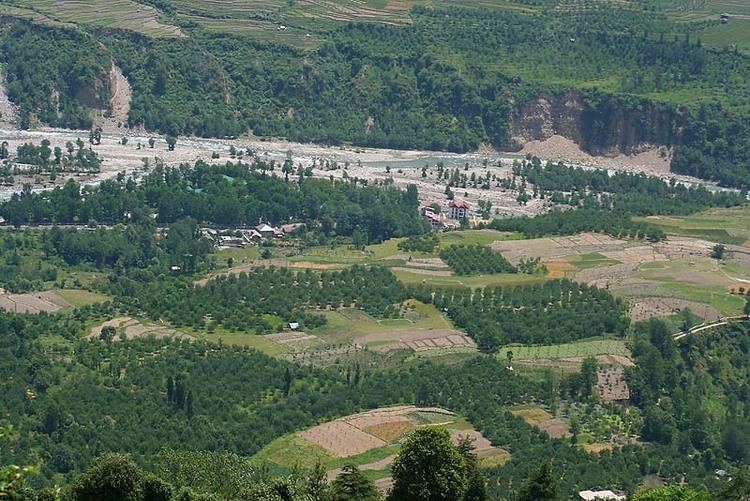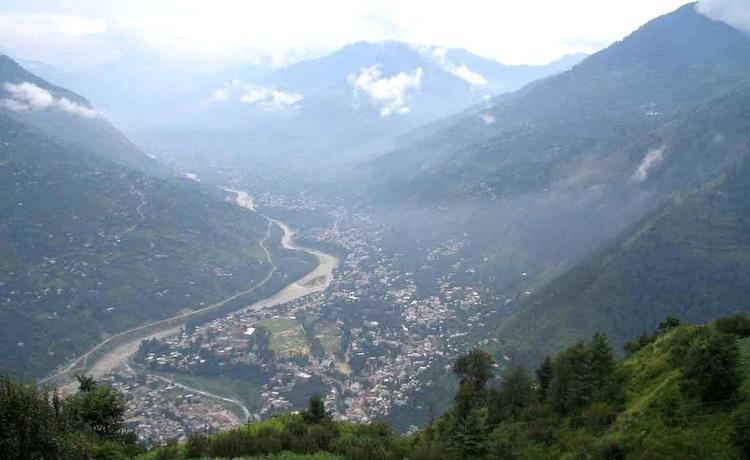Country India State Himachal Pradesh | Language spoken Hindi District Kullu | |
 | ||
Map of Kullu
Kullu or Kulu is the capital town of the Kullu district in the Indian state of Himachal Pradesh. It is located on the banks of the Beas River in the Kullu Valley about 10 kilometres (6.2 mi) north of the airport at Bhuntar.
Contents
- Map of Kullu
- Himachal tour packages shimla kullu manali for honeymoon and holidays
- History
- Geography
- Demographics
- Administrative
- Climate
- Air
- Road
- Rail
- Attractions
- Sightseeing
- Festivals and other activities
- Vicinity
- Food and fun in manali
- Rocky mayur enjoy dhaba lunch on the banks of the beas river
- References

Kullu is a broad open valley formed by the Beas River between Manali and Largi. This valley is famous for its temples, beauty and its majestic hills covered with pine and deodar forest and sprawling apple orchards. The course of the Beas river presents a succession of magnificent, clad with forests of deodar, towering above trees of pine on the lower rocky ridges. Kullu valley is sandwiched between the Pir Panjal, Lower Himalayan and Great Himalayan Ranges.

Himachal tour packages shimla kullu manali for honeymoon and holidays
History

Historical references about the Kullu valley dates back to ancient Hindu literary works of Ramayana, Mahabharata and the Puranas. During Vedic period several small republics known as "Janapada" existed which were later conquered by the Nanda Empire, Mauryan Empire, Gupta Empire, Pala Dynasty and Karkoṭa Empire. After a brief period of supremacy by King Harshavardhana, the region was once again divided into several local powers headed by chieftains, including some Rajput principalities, these principalities were later conquered by Maratha Empire and Sikh Empire.

The name Kullu derives from the word "Kulant Peeth", meaning "end of the habitable world". As per legends, during the Great Flood, Manu visited this valley, but was unable to cross the Rohtang pass. He named the last settlement he found as Kulant Peeth, and chose to settle and meditate in what has now become the town of Manali (Manu's Place). The name further devolved into "Kulut", as the kingdom was known for a long time; before finally being known by the current name of Kullu or Kulu.
The Buddhist pilgrim monk Xuanzang visited the Kullu Valley in 634 or 635 CE. He described it as a fertile region completely surrounded by mountains, about 3,000 li in circuit, with a capital 14 or 15 li in circumference. It contained a Stupa built by Mauryan Emperor Ashoka, which is said to mark the place where the Buddha preached to the local people and made conversions, Stupa was taken away by a Mughal ruler and put in feroz shah kotla maidan in Delhi. There were some twenty Buddhist monasteries, with about 1,000 monks, most of whom were Mahayanist. There were also some fifteen Hindu temples, and people of both faiths lived mixed together. There were meditation caves near the mountain passes inhabited by both Buddhist and Hindu practitioners. The country is said to have produced gold, silver, red copper, crystal lenses and bell-metal.
Kullu got its first motorable access only after Indian Independence. The long centuries of seclusion have, however, allowed the area to retain a considerable measure of its traditional charm. The road through the Kullu Valley and Lahaul is now paved all the way, to connect and provide the major access route between the northern Indian plains to Leh in Ladakh.
Geography
Kullu town has an average elevation of 1,278 m (4,193 ft). It lies on the bank of Beas River. A major tributary, Sarvari, (derived from "Shiv-Baardi") leads to the less explored and steeper Lug-valley on the west. On the east of Kullu lies a broad mountainous ridge having the village-temples of Bijli Mahadev, Mounty Nag and Pueed. Beyond the ridge lies Manikaran valley, along the Paarvati river which joins Beas at Sangam in Bhuntar. On the south of Kullu lie the town of Bhuntar, Out (leading to Anni, Banjar and Siraj Valley) and Mandi (in Mandi district). Historically Kullu was accessible from Shimla via Siraj valley or through passes on the west leading to Jogindernagar and onto Kangra. To the north lies the famous town of Manali, which through the Rohtang pass leads onto the Lahaul and Spiti Valley. One can see an enormous change in the climate as one climbs up the windward side of the ranges to proceed to the leeward and much drier plateaus to the north of Manali.
The valley has varied biodiversity, It has some of the rarest of animals like Himalayan tahr, western tragopan, monal and Himalayan brown bear. The Great Himalayan National Park (GHNP) is also located here. The park was built in 1984. It spreads over an area of 1,171 km2 (452 sq mi) which lies between an altitude of 1,500 to 6,000 m (4,900 to 19,700 ft). In order to protect the flora and fauna of this Himalayan area, many places are declared as wildlife sanctuaries, such as: Khokhan Sanctuary, Kais Sanctuary, Tirthan Sanctuary, Kanawar Sanctuary, Rupi Baba Sanctuary, Great Himalayan National Park and Van Vihar Manali.
Demographics
As of 2011 India census, Kullu had a population of 437,903. Males in kullu are 225,452 whereas females are 212,451. Sex ratio of kullu is 942 females per 1000 males which is higher than national sex ratio . The average literacy rate of kullu is 79.40% whereas male literacy rate is 87.39% and female literacy rate is 70.91%.
Administrative
Kullu town, as the administrative headquarters of Kullu district, has the offices of Deputy Commissioner, the Superintendent of Police and the District courts. It is also the largest and the most varied constituency of Lok Sabha, the lower house of the parliament of India.
Climate
December and January during winter observe lowest temperatures ranging from −4 to 20 °C (25 to 68 °F), with some snowfall.Evenings and mornings are very cold during winters. Annual highest temperature in summer ranges from 24 to 34 °C (75 to 93 °F) during May to August. Months of July and August are rainy because of monsoon, having around 150 mm (5.9 in) rainfall monthly. Climate is pleasant in October and November.
Air
The nearest airport (IATA code KUU) is at Bhuntar town, situated on NH21 at the confluence of the Parvati and Beas rivers (latitude 31.8763 N and longitude 77.1541 E), about 10 km (6.2 mi) south of Kullu town. The airport is also known as Kullu-Manali airport and has a runway more than a kilometre long. Indian Airlines and some private airlines have regular flights to the airport. Himalayan Bulls in collaboration with Deccan Charters started flights on Kullu-Chandigarh-Kullu sector beginning 2 April 2014 with 2 to 3 unscheduled flights each day in eight-seater planes.
Chandigarh airport is the nearest large airport.
Road
Kullu can be reached from Delhi by national highway NH 1 up to Chandigarh and from there by national highway NH21 that passes through Bilaspur, Sundernagar and Mandi towns. The road distance from Delhi to Chandigarh by bus is 260 km (160 mi) and from Chandigarh to Kullu is 252 km (157 mi); the total distance from Delhi to Kullu thus is about 512 km (318 mi).
Rail
Kullu is not easily approachable by rail. The nearest broad gauge railheads are at Una and Kiratpur Sahib (Both 200 kilometres (120 miles) away), Kalka 240 kilometres (150 miles) away, Pathankot 275 kilometres (171 miles) away, and Chandigarh (280 kilometres (170 miles). The nearest narrow gauge railhead is at Joginder Nagar (100 km [62 mi]) away.
Attractions
The Kullu valley is known as the "Valley of the Gods" or "Dev Bhumi" due to many pilgrimage sites for Hindus, Buddhists and Sikhs alike. Kullu is known for its open valley meadows and scenic views of the Himalayan mountain range. Kullu area is known for Kullu shawl, made of many natural fibers including pashmina, sheep-wool and angora. The seven-day festival of Kullu Dussehra, a celebration of Avatar Lord Rama's victory over the evil king Ravana. The festival takes place in the months of October or November, depending upon the Hindu calendar.
Sightseeing
Festivals and other activities
It connects with the Lahul and Spiti valleys via Rohtang Pass, situated at 3,978 m (13,051 ft) 51 km (32 mi) from Manali city.
Vicinity
Other places of interest in the area include Manikaran which is famous for its hot springs, and hot water springs at Vashisht village near Manali, 40 km north of Kullu, a hub for tourists and rock climbers. Malana, Kaish-Dhaar in Lug Valley, Bijli Mahadev, Bhekhli and Bajaura house the famous temples of the region and places like Kasol and Gohar. Manali is perhaps the most famous town and center of all tourist attractions in the state. Manali also has a well-known temple dedicated to the mythical princess Hidimba. which is known as Hidimba Devi Temple.
The economy of the town largely depends on tourism, horticulture (apples, plums, pears, and almonds) and handicrafts (shawls, caps, etc.). A majority of the youth depend on tourism for their well being, which has led to construction of a large number of hotels by locals such as the Himalayan Hamlet, Shivalik, Tree House, Apple Valley and Raju Bharti.
